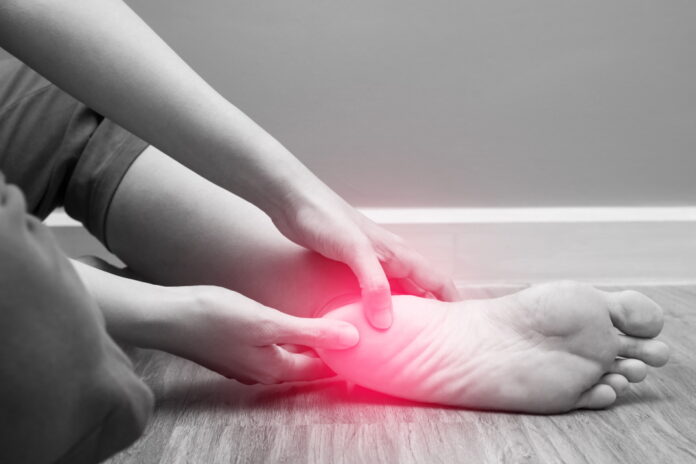
By Winston Lee L. Ac, Ph.D, KMD
Plantar fasciitis is a disease in which the plantar fascia – runs the entire plantar muscle from the calcaneus (heel bone) to the toes and is caused by inflammation. Simply put, the fascia that wraps the bottom of the foot muscles is swollen. The plantar fascia absorbs the sole’s impact when walking and helps lift the foot when walking. If tension and stress on this plantar fascia become too great, small tears can occur in the fascia. Repeated stretching and tearing can irritate or inflame the fascia, although the cause remains unclear in many cases of plantar fasciitis.
As many known causes of plantar fasciitis, flat feet with lower arches than normal are also considered a cause. However, there are other cases in which the foot’s arch is excessively higher than normal. The difference in both legs’ length is noticeable excessive exercise such as marathon or tennis and weight gain in a short period. There are important factors that cause plantar fasciitis. Age, types of exercise besides long distant running, and occupations that requires keeping you stand. According to the Mayo Clinic, the symptom is common between the ages of 40 and 60. Ballet dancing and aerobic dance can contribute to the onset of plantar fasciitis. And factory workers, teachers, and others who spend most of their work hours walking or standing on hard surfaces can damage the plantar fascia.
In particular, when the first step in the morning, the heel and sole are pulled severely, and the symptoms are typical, but the inner heel is often severely painful. Lifting the toes toward the foot’s dorsal area can get the pain worse, and the pain occurs when moving rather than standing still.
Plantar fasciitis is mostly caused by incorrect exercise posture or excessive exercise, so it is relatively common in men. Even in women’s case, it can easily occur even if they usually exercise excessively or often wear flat shoes or high heels. Therefore, to prevent plantar fasciitis, it is better to avoid uncomfortable shoes such as dress shoes and wear comfortable sneakers. Besides, it is necessary to adjust the amount and intensity of exercise to prevent excessive impact on the feet’ soles. If you exercise, be sure to do enough stretching and warming up before making sure you have enough blood circulation throughout your body to prevent plantar fasciitis.
Wearing a splint that stretches a patient’s calf and the foot’s arch while sleeping could be recommended. The splint holds the plantar fascia and Achilles tendon in a lengthened position overnight to enhance stretching.
Plantar fasciitis cannot be improved without special treatment, but it may take several months or more for a year or longer to heal naturally. Therefore, if left unattended without proper treatment, the risk of progressing to the chronic stage is high, and symptoms often recur. Therefore, appropriate treatment and constant checkups are required rather than neglected.
Treatment for the symptom can be commonly suggested in western medicine is taking anti-inflammatory pain relievers as much as possible without exercise for a while. In more severe symptoms, steroid injection treatment is usually advised by the MD on the sole as the priority.
Steroid injections often suppress the inflammation in the affected area quickly, and the pain disappears immediately. However, in this case, the artificial hormone steroid itself has quite a side effect, so you need to be careful of repeated use and overuse. Commonly known side effects of steroid injections are pain around the injection site, face flushing for a few hours, thin or pale skin around the site, and insomnia.
Steroids have an excellent effect of reducing pain rapidly, so immediately after the procedure, the patient does more exercise or walking, causing more damage to the plantar fascia and eventually prolonging the entire healing period.
In this case, if acupuncture treatment is used, pain can be controlled in a short period without side effects from steroids. The points I mainly use are KI2, BL64, BL65, etc. Through these points, I aim to stimulate the plantar fascia as if slicing a raw fish from the foot’s inside and outside. The accurate acupuncture in these points will have a significant pain relief effect on the day or the next day. Still, the sole itself is so sensitive that the patient feels pretty big pain from the acupuncture treatment itself. Therefore, it is possible to reduce the pain with the acupuncture treatment session by explaining it to the patient in advance and ensuring that the patient has a comfortable posture when taking acupuncture.
It would be best to educate the patient to continue the exercise at home, such as massage the inside of the soles with a tennis ball and frequent stretching the calf muscles. Plus, it would help if you taught the patient always to wear a customized console device upon the doctor’s prescription to maintain the foot’s longitudinal and transverse arches.
































